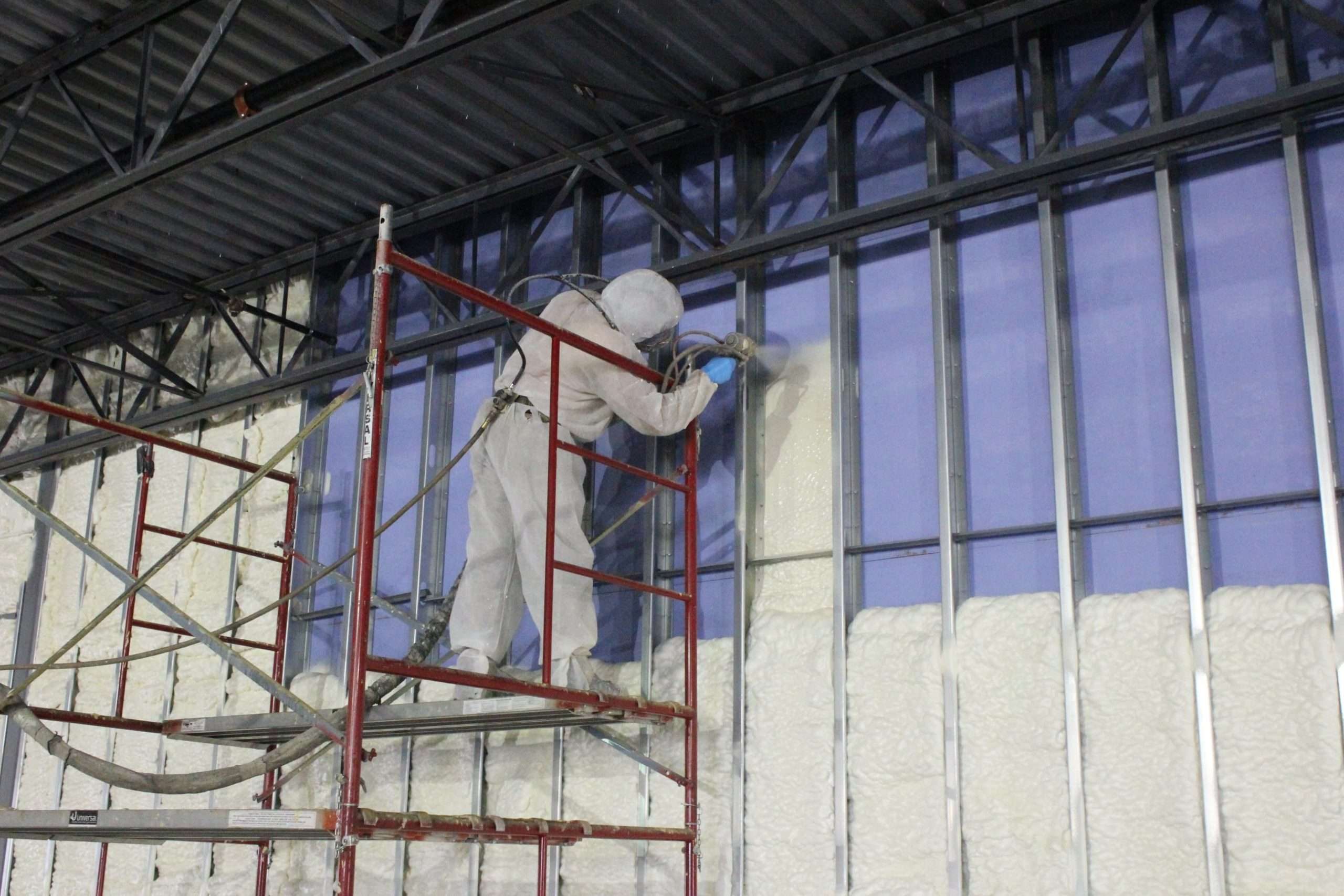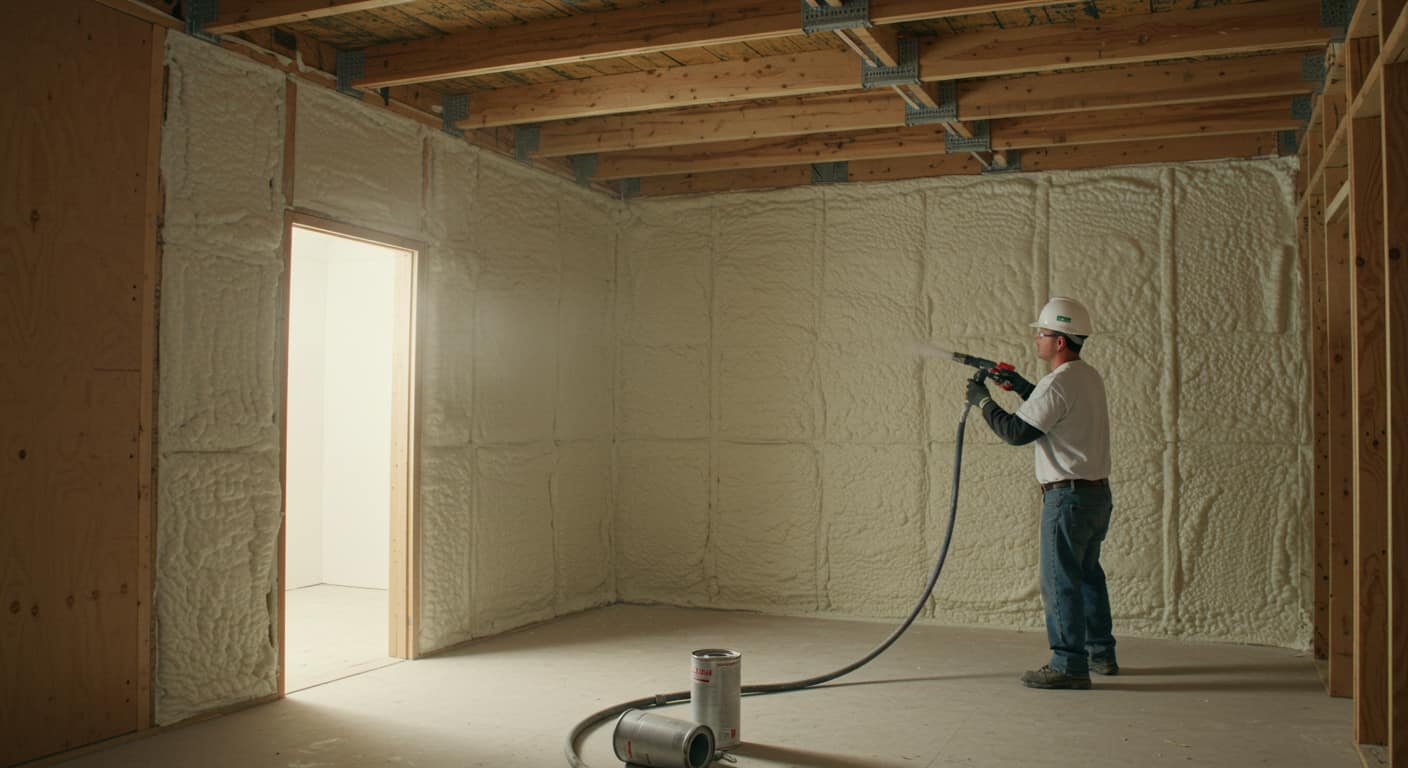Imagine you’re in your cozy home, but outside noises keep disturbing your peace. Wouldn’t it be great if there was a solution?
Well, spray foam might just be what you’re looking for. It’s not only an excellent insulator but also a fantastic sound barrier.
Let’s delve into how spray foam can turn your abode into a quiet haven, enhancing comfort by controlling unwanted noise.
The Science Behind Spray Foam and Sound Control
You’re probably wondering how the science behind spray foam helps in sound control, aren’t you? The secret lies in its foam composition. Spray foam is created from two types of composite materials, polyol resin and isocyanate, which react when combined to expand and harden. This unique reaction creates a dense, yet flexible barrier.
Now let’s talk about sound transmission. Sound waves travel through air and solid objects. When these waves hit a wall or ceiling, they cause vibration – this is what your ear picks up as noise. However, the density of spray foam effectively absorbs these vibrations, reducing the amount of sound that can pass through it.
So with spray foam insulation installed, you’re not just keeping heat in; you’re also keeping unwanted noise out!
Benefits of Using Spray Foam for Noise Reduction
When it’s used for noise reduction, spray foam insulation can significantly enhance your living environment by muffling disruptive outside noises. It can indeed mitigate the noise pollution impact that’s so prevalent in our busy modern lives.
It offers a couple of major benefits:
- Affordability: Despite popular belief, spray foam is realistically affordable. It’s cost-effective considering its long-term benefits.
- Energy Efficiency: Spray foam seals air leaks, reducing energy bills.
- Durability: Its strong and flexible nature makes it last longer than other insulation types.
- Comfort Enhancement: Along with reducing noise, spray foam also contributes to thermal comfort.
- Temperature Control: It keeps your home warm during winter and cool during summer.
- Noise Reduction: Spray foam helps maintain peace by blocking exterior sound.
You’ll surely appreciate the difference that spray foam brings to your home!
Also Read: Is Spray Foam Insulation Flammable?
How to Apply Spray Foam for Optimal Sound Control
Applying this insulation type correctly is crucial to optimize its noise-reducing capabilities in your home. Proper foam placement and application techniques play a significant role in maximizing spray foam’s performance. Don’t just place it haphazardly; strategically position the foam where noise often penetrates, like walls adjoining noisy areas or windows facing busy streets.
When it comes to application techniques, don’t skimp on the details. Make sure you’re applying an even layer of the foam, filling all gaps and cracks thoroughly. Remember, inconsistencies can compromise the soundproofing effect.
Lastly, keep safety in mind during application. Protective gear isn’t optional; it’s essential to avoid any potential health risks.
In short, correct placement and application are key to using spray foam effectively for sound control.
Case Studies: Real-life Applications of Spray Foam for Sound Control
Let’s dive into some real-world examples where this insulation technique has been used to effectively reduce noise. Despite installation challenges, spray foam varieties have been utilized in various scenarios:
- A musician transformed his garage into a recording studio, drowning out external noise.
- A homeowner living near an airport significantly reduced the sound of overhead planes.
- A city dweller found peace in her apartment by blocking out street sounds.
- An office building enhanced productivity by creating quieter workspaces.
In each case, you’ll notice the powerful impact of spray foam. It’s not only about physical comfort but also mental well-being. Even with hurdles during installation or choosing between foam types, the results prove it’s worth it!
These stories aren’t just about noise reduction; they’re about improving quality of life.
Comparing Spray Foam With Other Sound Control Methods
It’s critical to compare this insulation technique with other noise reduction methods to understand its superiority. When you consider the spray foam lifespan, it outperforms many alternatives by providing long-lasting noise control.
As an eco-friendly insulation option, it also contributes positively to your home’s energy efficiency, reducing both your carbon footprint and energy bills.
While traditional insulations might seem a cheaper option initially, their effectiveness diminishes over time. You’ll find yourself replacing or supplementing them often. Spray foam doesn’t settle or sag over time like fiberglass or cellulose, maintaining its structure for years.
Lastly, let’s not forget the health aspect. Spray foam doesn’t contain harmful particles that can circulate in your indoor air. It’s a win-win solution: superior sound control plus environmental responsibility!
Frequently Asked Questions
Q: What Are the Cost Implications of Using Spray Foam for Sound Control?
A: You’ll find spray foam is cost-effective considering its durability. Though the installation process might seem pricey initially, it’s a one-time expense that cuts noise pollution, boosting your comfort for many years to come.
Q: Are There Any Health or Safety Concerns Associated With the Use of Spray Foam?
A: You’re probably terrified of foam toxicity, right? While it’s not a walk in the park, with proper application precautions, you’ll stay safe. However, always hire professionals to ensure correct installation and minimize risks.
Q: Can Spray Foam Be Used in Combination With Other Sound Control Methods?
A: Yes, you can combine spray foam with other sound control methods. Foam compatibility and installation techniques matter. It’s crucial to ensure they work together effectively for optimal soundproofing results.
Q: How Long Does It Take for Spray Foam to Dry and When Can I Start Noticing Its Sound Control Benefits?
A: Spray foam’s drying time depends on various factors, including its thickness. It’ll take about 24 hours to dry completely. You’ll start noticing the sound control benefits immediately after it’s fully dried and cured.
Is Spray Foam Effective in Controlling Both High and Low Frequency Sounds?
A: Yes, spray foam is effective in controlling both high and low-frequency sounds. Foam types and the installation process play an essential role in dictating its effectiveness. It’s vital to install it properly for optimum results.
Conclusion
So, you’ve learned the magic of spray foam in sound control. It’s not just good, it’s a game-changer! From boosting comfort to reducing noise, it’s your ultimate solution.
Don’t just take our word for it, try spray foam and hear the difference yourself. Remember, nothing compares to a peaceful environment where silence isn’t golden but priceless!
Looking for spray foam insulation experts, Contact us Now!







